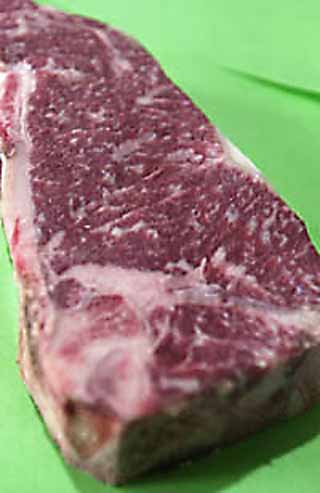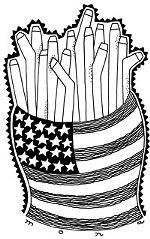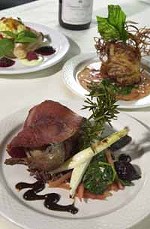Prime Considerations
Why Japanese Wagyu cattle are thriving in central Texas
By Rebecca Chastenet dé Gery, Fri., Nov. 16, 2001

Kobe beef, the Japanese red meat delicacy from the city of the same name, has come to Austin. Nearly 1,000 head of Wagyu cattle, the Japanese bovine breed to which the Kobe belong, populate the 3,000-acre Harrell Ranch adjacent to Lake Walter E. Long. While the Harrell Ranch herd doesn't receive the daily massage that has made their Japanese counterparts world famous, the cattle are no less pampered. (Wagyu cattle in Kobe are generally raised in a space no larger than an average Austin efficiency apartment; Harrell Ranch cows have plenty of Texas range to roam, so the massage isn't really necessary.)
Massage aside, from the time they are conceived to the time they reach the kitchen, Harrell Ranch cattle get special attention -- attention that makes them, and the meat they ultimately become, notably different from most of the rest of the state's 13 to 14 million head of cattle. Renowned chef Charlie Trotter of Chicago uses Harrell Ranch Prime grade Wagyu beef. So does Thomas Keller of Napa's touted French Laundry. The high-end Allen Brothers catalog, a popular purveyor of Prime beef, relies on Harrell Ranch. And Omaha Steaks, one of the nation's leading mail-order beef purveyors, exports Harrell Ranch beef to Europe because it is hormone- and antibiotic-free. In Austin, high-end restaurants like Kenichi and Wink, Bistro 88, Jeffrey's, and Hudson's on the Bend swear by Harrell Ranch's Wagyu.
According to Harrell Ranch owner and president Sam Harrell, a number of things set his beef apart. To begin with, the ranch concentrates on raising the increasingly rare USDA Prime grade of beef cattle, and Harrell claims that the ranch is the only cattle operation in the United States that manages its beef from birth all the way to the chef, marketing directly to restaurants as opposed to selling the cattle to feed lots after a few short months. Then there's the ranch's certification as one of only 24 ranches in the United States -- and the only ranch in Texas -- to raise USDA-certified Non Hormone Treated Cattle. (There are other ranches in Texas that raise certified organic beef, but Harrell Ranch is the only one with USDA non-hormone certification, which allows its product to be exported.) Furthermore, notes Harrell, his cattle are fed differently and managed differently then most beef cattle. And Harrell Ranch beef is dry-aged, as opposed to the so-called wet "aging" that most other beef receives, at one of the few remaining facilities of its kind in Texas.
"You can always tell the pioneers by the arrows in their back," says the no-nonsense Harrell matter-of-factly as I stare at him in utter surprise. What the man has just told me goes against conventional American ranching wisdom. (Not to mention the fact that I feel like I've just hit the "foodie jackpot," uncovering a little-known local food treasure -- something increasingly hard to do in this food-conscious town!) At this point I know nothing of the Wagyu breed's genetic disposition for lower cholesterol content, or even that I can buy the rare, Prime grade beef, cut to specification, from the ranch's retail operation, The Meat Shop. But before I get over-enthusiastic and "buy the farm," Harrell calls in Ranch manager Bubba Kay, a strong, silver-haired cowboy with Paul Newman blue eyes, to explain the way things are done around the ranch.
Kay briefs me on standard American Ranching 101, outlining how the country's "grow 'em as fast as you can" model typically plays out. Calves, he explains, are typically sold after they are weaned at around seven months, and then given supplemental feed in addition to the grass they consume, so that by about 14 to 16 months, before they reach skeletal maturity, they will have amassed a maximum amount of weight for slaughter. The rush to put weight on the cattle, explains Kay, often leads to the use of anabolic steroids and growth hormones, and many cattle are treated with antibiotics and fed animal by-product-laced feed or appetite-stimulating feed additives along the way. Put simply, more cow means more money.
Harrell Ranch cattle follow a different path. Half-blood Angus and Wagyu cattle are bred with Wagyu bulls to produce calves that are three-fourths Wagyu and one-fourth Angus, and at birth, a computer chip is implanted in each calf's ear. From that point on, insists Kay, ranch hands enter information on the calf each time they catch it. After weaning, at around seven months, calves are put out to pasture to graze until 13 to 14 months of age. Then, as Kay puts it, "the cattle get their year in the country club," his uniquely-designed, low-density feed facility, where they are given a corn/cotton seed feed mixture ground each morning by Kay, plus "all the hay they can eat."
While living in the feed lot, a cow's weight gain is actually restricted, with an allowable two-pound maximum weight gain per day limit. "This increases the natural marbling in the meat," he notes, explaining that the high-quality marbling desired in beef occurs within the muscle mass. "Marbling is the last thing to come on a calf, which is why we aim for skeletal maturity, and the first thing to come off due to stress," explains Kay. "Marbling is fat," interjects Harrell, "but intramuscular marbling is the good kind of fat -- the fat high in monounsaturated fatty acids. Beef back fat is what's high in cholesterol, and our meat cutters trim that."

But why Japanese Wagyu cattle in Texas?
It all began as a race against time. In 1993, Sam Harrell, a semi-conductor technologist who grew up on a ranch roamed by San Gertrudis cattle, was attending a routine meeting of the Texas A&M Board of Chancellors. During the meeting, he says, an agricultural study conducted by the university's researchers was unveiled, revealing that the U.S. consumer demand for Prime beef hovered around 9%, while only a startling 6% of the U.S. beef supply qualified for the Prime grade. The study went on to predict that within a few years' time, the nation's stock of Prime grade beef would fall further, to only 3% of the cattle raised, before plummeting to a mere 1% by decade's end. (Their predictions have rung true: Harrell notes that in the last four months of 2001, USDA Prime grade beef accounted for only nine-tenths of 1% of all the cattle raised in the country.)
Clearly, the study concluded that Prime beef was scarce, but the consumer demand for it was not disappearing. To fill the void, the report's authors recommended replenishing the nation's Prime stock over 25 years using a genetic-selection model applied to existing breeding stock. Slowly but surely, the researchers determined, the number of head of Prime grade cattle roaming U.S. ranches would increase until it reached 9%.
Sam Harrell's response to the study was an emphatic "I can save you 25 years!" Harrell's philosophy was to start with genetics that work rather than to hunt down, and then wait on, the genetics that would ultimately replenish Prime cattle stocks. To find existing Prime-grade genetics, Harrell looked to Japan, where beef grades go several grades above Prime. He eventually assembled 100 head of mixed breed Wagyu and high-marbling Angus cattle, and within three years, Harrell Ranch cattle were stamped "Prime."
Today, the ranch's objective is "to serve the top 5% of the United States' Super Prime retail market," avoiding competition with what little commercially raised Prime grade cattle does exist on the market. Harrell Ranch also aims "to serve the top 1% of the best white tablecloth restaurants in the nation, and promote healthy, rich-tasting, gourmet beef to America." That's a tall order, one Harrell admits the ranch will have to be careful about achieving. "If we come on too strong," he explains, "we'll create too high a demand for Prime Wagyu beef, which will encourage charlatans in the market."
The good news for Austinites is that serving delicious Prime or the "Super Prime" Kobe grade beef at home is as simple as a drive to Peyton Gin Road, to the remarkably unassuming, USDA inspected and certified Meat Shop.
The day I visited The Meat Shop, Henry Sainz, who is in charge of production at the store, led me back to the aging cooler, where deep garnet-colored cuts of meat hung fully exposed to the air. "This is going out to Charlie Trotter," mentioned Sainz, pointing to a cheesecloth-wrapped mass of red meat. The cloth was notably clean and white, with no trace of blood, which Sainz explained is because the meat is dry-aged. "We dry-age our beef at 36 degrees for 28 to 31 days before cutting it," he explained, "and each cut of meat is individually sealed -- vacuum packed -- to guard freshness." This insistence on dry-aging is another distinguishing factor of Harrell Ranch beef.
Across the country, "wet-aging," or hanging beef in sealed bags for three to four days before cutting it, has replaced dry-aging. Wet-aging is a misnomer, says Sainz, who explains that the "more cow means more money" maxim works at this level of the beef business, too. Wet-aging doesn't allow for the loss of beef's blood or water content, which means that wet-aged beef weighs in heavier and subsequently fetches higher prices. "We lose almost one-third of our Prime grade weight in dry-aging," says Sainz. "On the Kobe grade, we lose almost 50% of the total weight." It doesn't take a math wizard to question the business acumen of holding on to the practice of dry-aging, but Harrell and Sainz insist that dry-aging can't be beat on the flavor front. Wet-aging doesn't allow for the breakdown of the beef's connective tissue, which improves its tenderness, or for the purging of impurities. Besides, Sainz notes, with wet-aging, consumers are essentially paying for water and blood, not beef.
Because it is handled differently from the get-go, Harrell Ranch's Wagyu beef demands a conscientious chef. Overcooking the meat can lead to undesirable toughness and loss of the beneficial oleic acids contained in the meat's marbling. In fact, Sam Harrell recommends cooking his beef on aluminum foil on the grill to prevent the flames from touching it directly. "Our meat may cost a little bit more because it's scarce," says Harrell, "but we've made converts out of dozens of chefs across the U.S." ![]()








